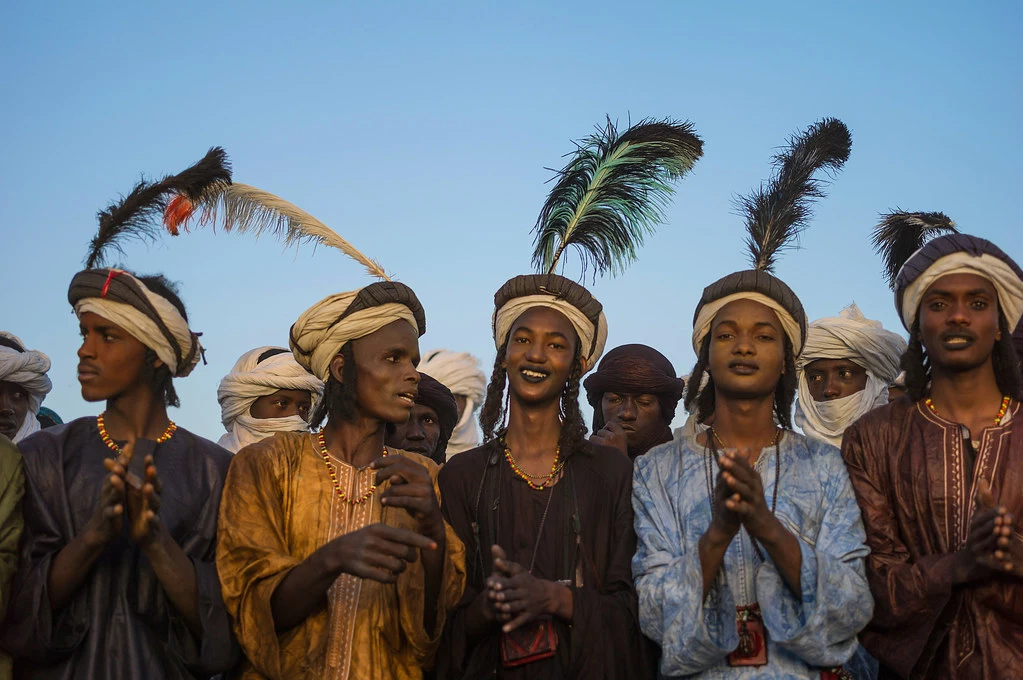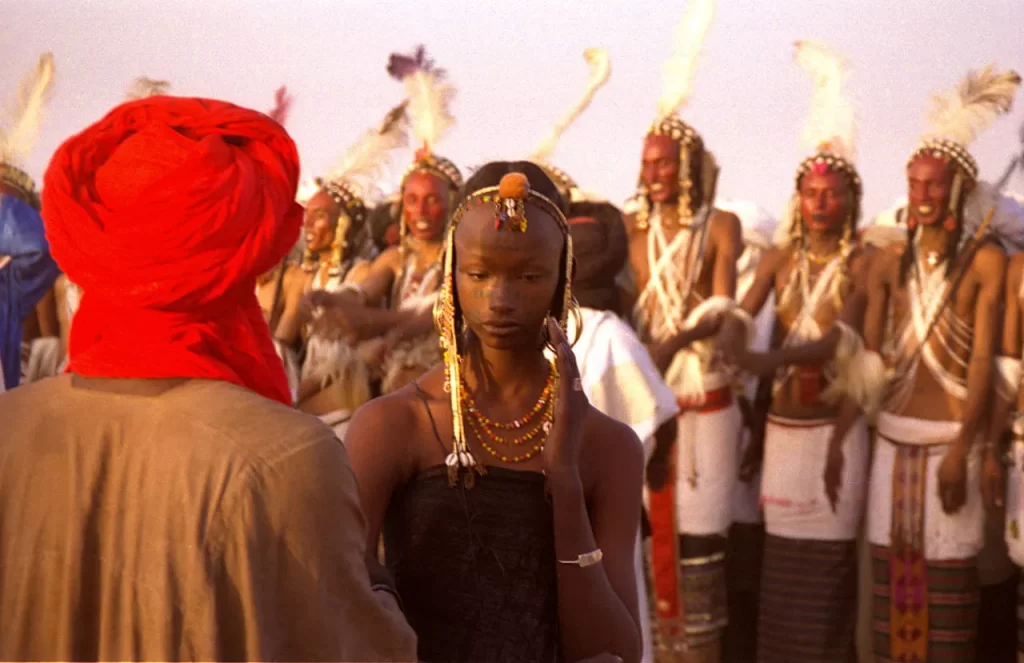Also going by the name Mbororo or Bororo, the Woodabe are a minority group within the Fulani ethnic group. They inherit the traces of their ancestors in nomadism and trading and they occupy the Sahel region of West Africa.
Their population, which ranges between 160, 000 and 200,000 according to the most recent census, is scattered in Niger, through to Northern Nigeria and northeastern Cameroon, the southwestern parts of Chad and also the western region of the Central African Republic. The Wodaabe communicate using spoken Fula language and don’t have a written language. Below are some amazing facts about these Herdsmen of the Sun.

- Beauty Is Very Important To The Wodaabe People
Unlike most other African ethnic groups which value women’s beauty, the Woodabe value and cherish beauty, especially on the side of the men. The Woodabe have elaborate attire and beauty ceremonies. Their culture fancies height, a slim body, a facial figure, white eyes, and white teeth. These are regarded as the pillars of beauty.
The Woodabe men wear brightly-colored makeup and paint their eyes to make their beauty more visible. Usually, they add feathers to their headdresses to make their height more pronounced. At other times, they use red ochre to decorate their faces and they usually spend a long time attending to their hair.
- The Wodaabe Women Have Much Higher Sexual Freedom Than Their Male Counterparts

Surprisingly, the Woodabe women have their sexual boundaries wider than that of their husbands or the men. They can have more than one husband or sexual partner. When it gets to sexual matters, the women have the steering wheel and make the decisions on who they prefer, depending on beauty and attraction, either for one-time sex or for a lifetime companionship.
The unmarried girls are permitted to have sexual relations with whoever they wish, whenever they feel like. Though their initial marriage is arranged by the parents during the children’s young age (called koogal), they can later marry their preferred partners driven by love and attractions, referred to as teegal.
- They Were Among The First Muslim Converts Outside The Middle East
During the late sixteenth century and early seventeenth century, the Fula people inhabiting some parts of West Africa were among the first ethnic groups to convert to Islam. Although there is a sense of other beliefs still exhibited among these people, the bigger part of the population adheres to the basic guidelines of Islam. Some of them became the leaders propagating the spread of Islam.
Ever since, they have found pride in this urban, literate and saintly life of their religion. The wealthy and powerful make part of the most religious population while the less powerful and those owning fewer resources are less concerned about adhering to the religion.
History says that the Islam religion has been used in the past to justify the ‘holy jihads’ that made the northern territories of current Nigeria under the patronage of the Fulani and Wodaabe leaders.
- They Practice High Ethical Standards
The Woodabe stick to their code of behavior, which stresses care and forethought (hakillo), reserve and modesty (semteende), loyalty (amana), and patience and fortitude (munyal).
Among the men, each man, though monogamous in nature, is only allowed to have one sexual partner at a time. They are known as People of Taboos, due to how they strictly adhere to the different taboos and traditional ways of life. This makes them presentable as well as acceptable as per the regulations of their culture.
- After Their First Child, A Couple Is Not Allowed To Speak To Each Other For Some Time
The Woodabe woman stays with her husband until she gets pregnant, from when she goes to stay with her mother until childbirth. After childbirth, she is not allowed to get into sexual relations or contact with her husband. They should not hold hands or speak directly to each other, especially during the day.
The man is prohibited from expressing any interest in either his wife or the child. After two to three years, the woman is permitted to visit the husband but they shouldn’t live together or bring up the children together. The first two babies are raised by their grandparents.
- Men Model Themselves During A Ceremony Called Guérewol
This serves as the most important ceremony among the Woodabe people, especially the young ladies. During the Guerewol, or the gerewol, the men beautify themselves, wear makeup and spend hours painting themselves for the dance, from which the women play the judges and pick for themselves lovers or marriage partners. The women must have had menstruation shortly before the event, which makes them likely interested in sexual affairs.
After a woman picks the man who interests her, and if the man agrees, the two would probably have sex that night, either for a one-time affair or one which would lead to marriage.
The dance happens in September and there is no harm even if a married woman picks a suitor for one-time sex or even for a marriage. This means, at times, ignoring one’s marriage vows and choosing a new partner, temporarily or permanently. The men dance gerewol to win a lover, which at times means stealing another man’s wife.
- They Highly Sought After Art In Fabrics And Jewelry
Art in fabric works and jewelry are highly embraced among the Woodabe. They use fabric to decorate bags, containers, amulets and garments, especially the ones worn during the Gerewol. Women do the embroidery, but men also get involved in designing the art, especially when it touches on the dressing for their Gerewol.
Most of the art and the designs evident in fabrics and jewelry are symbolic, mirroring real-life objects and usually have name tags, for example, ‘calf-rope’, ‘sleeping children’, ‘starts’ and ‘cow’s eyes’ among other designs. This art, depicted in the different clothing and other materials they use in daily life, makes both men and women look beautiful in the eyes of the other gender. It also preserves their culture and passes on the traditions of the people to the younger generations.
